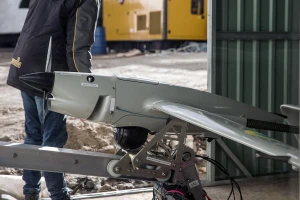
Ukrainian drone development during war and UAV strikes on Russian troops. Column by Serhiy Zgurets
Discussion will revolve around ystematic dismantling of the Russian occupying forces by the Ukrainian military, the UAV manufacturing, and the requirements for their advancement
Ukrainian military strikes on Russian troops
I'll begin with three prime instances of high-precision targeting, including the effective neutralization or elimination of Russian forces, achieved through a seamless integration of intelligence and destructive capabilities. The first example: The South defense forces published a video of strikes on a cluster of Russian troops near the village of Podo-Kalynivka in the temporarily occupied part of the Kherson region. These are the Oleshky Sands, where the Russian troops decided to set up training grounds. According to Natalia Humeniuk, head of the Joint Coordination Press Center of the Southern Defense Forces, assault groups were training there to practice their coordination. After detecting Russian forces with the help of Ukraine's unmanned aerial vehicle, the Ukrainian Defense Forces launched two strikes using the HIMARS rocket launchers. According to preliminary data, about 60 Russian soldiers were killed. Podo-Kalynivka is located 27 kilometers from Krynky, the place of fierce fighting where Ukraine's marines are holding a bridgehead on the left bank of the Dnipro River and Krynky, where the Russian Defense Minister falsely claimed that their army had managed to capture the bridgehead. This is, of course, completely untrue.
The second story is about a strike on a lineup of Russian troops that the Ukrainian Armed Forces launched on February 20. This time, it was at a different training ground, near the occupied village of Trudivske, Volnovakha district, Donetsk region. There, three companies of the 36th Russian motorized rifle brigade lined up and waited for their superior, but the Ukrainian HIMARS missiles came much faster. The propaganda outlet Vazhnye Istorii listed the names of 68 Russian soldiers killed, although there were certainly more wounded.
All signs point to the effective coordination between weaponry and reconnaissance, particularly evident in strikes on the Kherson region, the training ground. These operations showcased the integrated efforts of both HIMARS and Ukraine's domestic UAV SHARK.
Just a couple of hours ago, I learned about another good example of the use of HIMARS, artillery and drones, as a logical continuation of the two previous examples. This morning Russia launched an attack on Ivanivske near Bakhmut. In the morning, there were five infantry fighting vehicles with troops in the first group, they somehow managed to slip through the minefields and entered the village. They were suppressed by drones and artillery, so the lion's share of the Russian group was entrenched in the school. Ukrainian soldiers called for an ambulance in the form of HIMARS. The school was hit precisely and they suffered many casualties. The Russian forces still did not calm down, there were still armored groups, they tried to storm Ivanivske again and all these 9 Russian IFVs were destroyed. In total, about 100 Russian infantrymen tried to attack Ivanivske, and 60 of them were killed and the rest were wounded. None of the Russians left Ivanivske, so taking into account these events that took place yesterday, I think that the next day we may see an increase in the number of Russian soldiers killed in the General Staff statistics.
Ammunition resupply to the Ukrainian Armed Forces
I was told that Ukraine's military, who were destroying Russian offensive groups near Ivanivske yesterday, got some ammunition. I don't know where they got it from, perhaps it's some reserves that were transferred to Ukraine's military to prevent Russian troops from advancing to Chasiv Yar, which is something they are extremely eager to do. However, there could have been more ammunition, of course.
If we consider that just a couple of days ago, Czech President Petr Pavel spoke about the possibility of supplying Ukraine with 800,000 rounds of ammunition, 500,000 of which are 155 mm caliber and another 300,000 of 122 mm. But this ammunition, which Petr Pavel found somewhere, can be delivered to Ukraine within weeks if other countries finance its delivery, such as the United States, Germany, or Sweden.
In fact, the Czech press wrote a little earlier that countries such as Turkey, South Korea, and others have a certain amount of ammunition that they can deliver to Ukraine or other countries, and then Ukraine receives it. So this process is ongoing.
There have been reports that Canada has committed to raising $22 million, presumably for the purchase of the ammunition Petr Pavel mentioned. It's important to note that this $22 million is specifically allocated for ammunition, and if we consider an average cost of $5,000 per shell, it would be sufficient for approximately 4,500 rounds. While this is a positive development, it falls short of meeting the requirement for the entire 800,000 rounds needed. If Ukraine does get it, then at an average rate of 5,000-6,000 rounds per day for five months, Ukraine's Armed Forces will be able to effectively conduct defensive operations. Currently, Ukraine is firing about 2,000 to 3,000 rounds per day, which is about three times less than Russia uses in certain areas.
Supply of UAVs for the Ukrainian Defense Forces
Next, let's talk about the fact that while Ukraine is waiting for ammunition, both FPV drones and reconnaissance drones are actually creating the possibility of using other means of destruction to deter Russia's advance. In 2023, the Ministry of Defense said that the number of Ukrainian companies that manufacture both FPV drones and other UAVs had increased significantly. However, there are companies that have a stable history, an unmanned product that has already proven itself in combat, and when the Ministry of Defense or the Ministry of Digital Transformation says that they are making decisions related to improving certain procurement procedures, accelerating the supply of components, it is very important to analyze all these statements through the examples of specific companies to understand what the reality is.
The Athlon Avia Scientific and Production Enterprise supplies the Ukrainian Armed Forces with the A1-CM Furia unmanned reconnaissance and fire control system.
When asked how the realities on the battlefield affect the improvement or change of the complex itself, the company's director Artem Viunnyk answered: "Of course, the dynamics have changed in recent times, and this dynamics requires manufacturers, not only us, but all Ukrainian manufacturers, to quickly implement new ideas, new solutions that should make the products even more effective, even more resistant to enemy electronic warfare. Because they are very powerful, and we need to talk about it, we shouldn't underestimate their capabilities. Today, virtually everyone, both more experienced companies and younger ones, are involved in a kind of race for the best, most stable, longest-flying drone. I think it's very cool, and it's a kind of challenge for companies like us."
According to him, despite the war, some competition continues, because the motivation to grow and develop does not fade away. This is how the military on the battlefield gets better and newer products.
Creation of the Unmanned Systems Forces
Artem Viunnyk, the company's director, emphasizes the importance of expediting the interaction process between the Ministry of Defense, the military, and manufacturers. He believes that effective communication is the initial requirement, and to achieve this, it is crucial to await official regulations and instructions from the authorities. It is essential to gain a clear understanding of the place, role, and tasks assigned to these troops within the Armed Forces of Ukraine.
"On the other hand, it is true that unmanned systems have already taken their rightful place in the weapons system, and this initiative of the president is very correct. Again, we should not think that this new type of troops will take over all unmanned solutions and they will be only there. I think that this type of troops should actually take care of some systems that are, let's say, quite specific. For example, maritime drones as a means of destruction, or some ground robots used in certain special operations," said the director of the scientific and production company Athlon Avia.
Viunnyk hopes that the command will harmonize all this. He also emphasizes that unmanned solutions should penetrate all branches of the military, but the Army and Air Force probably won't.
The best advice to the authorities is to communicate with manufacturers, invite companies with experience and those that are just starting out to the table to build an ecosystem when there is a request from the Ukrainian Armed Forces and industry for entrepreneurial opportunities.
"This is actually a key thing for development. Without long-term planning, it is impossible to talk about any capacity. Today, we can produce even at capacities that are significantly larger than our orders. It is unclear why we still have no orders, for example, from the State Special Communications Service; we have started cooperation with the newly formed agency and hope that this year we will be able to talk about contracting in 2025, and preferably in 2026 and 2027. Because this should give a certain impetus and confidence to the overall planning and personnel policy, our financial resources, and production capacities," explains Viunnyk.
R&D solutions for drone manufacturers
For modern companies, it is important to engage in R&D, which helps businesses improve the development of technologies and new products.
"They are relevant for our company as well. I believe that R&D is the most important thing manufacturers should pay attention to today, because the battlefield is changing significantly and quite dynamically. We must not only react, we must be proactive, i.e. offer solutions that can, for example, change the rules of the game, and only the introduction of new technologies, ideas, and solutions can give us such a result. We can't stand still, so R&D is the most important activity in our company, and I'm sure I can see the results in other companies that deal with unmanned systems," summarized the director of the scientific and production company Athlon Avia.
- News












































